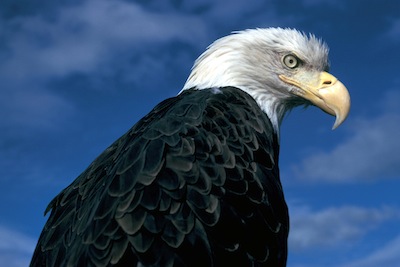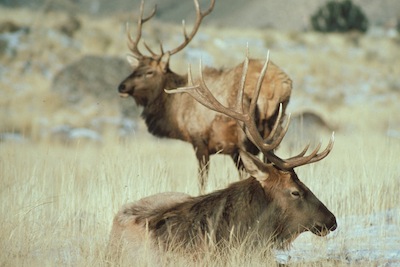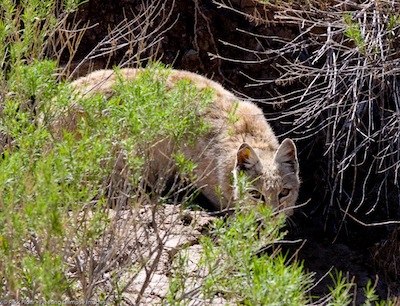
Safety in viewing wildlife is parks priority
The line between the national parks as tourist attractions and the national parks as wildlife preservations is getting ever so thin, a number of park officials believe.
“People that are coming into the parks are used to a Disney-like environment that are constructed and managed when in fact they are wild,” said Linda Friar, public information officer at Everglades National Park.
Rangers and safety personnel understand that one of the main attractions of coming to a park is to see nature in its purest form, but personnel say that people need to learn to keep their distance and understand what they’re dealing with.
| Click on the video at the right to view an audio slideshow about safety around wildlife in the national parks prepared by writer Chris Wittyngham. Photos courtesy of the National Park Service. |
“I think that there are many visitors that come to the park and do not recognize that these are dangerous wild animals,” said Nancy Gray, spokesperson for the Great Smoky Mountains National Park.
Gray says that the biggest source of this is that people wanting to get the great pictures available at the park, particularly of wild animals like bears, deer and elk. Not only is there appeal in photographing these animals, but there is even more excitement and energy about taking pictures of these animals in their native habitats, photos only available at the national parks.
 |
Exotic animals such as the bald eagle found in numerous national parks are one of the main attractions (Photos courtesy of the National Park Service). |
“Everybody wants to view these animals and the excitement takes over and they try to get as close as they can to get a photograph and they put themselves in danger,” said Gray. “They’re getting too close to take a wild shot.”
The issue of people getting to comfortable in dangerous areas is a prevalent one in incidents involving injuries at the park. Friar said a visitor at Everglades left their child on a rock close to an alligator.
Bonnie Schwartz has also experienced similar issues at Yellowstone National Park.
“A lot of the people near the old faithful geyser basin walk on a boardwalk and are often perfectly comfortable being three or four feet away from the bison in the area,” said Schwartz, deputy chief ranger at Yellowstone.
| At right, elk are one of the many kinds of animals you’ll see in western mountain parks such as Yellowstone, Rocky Mountain, and Grand Teton. Below, wolves are more common in parks today and visitors should keep their distance from these animals. |
 |
Yellowstone dealt with a public safety tragedy earlier this year. On two occasions this year, people camping in the park were killed after being mauled to death by bears.
“I’ve been here for 10 years on and off as a ranger. Every year we have medical situations and search and rescue situations,” said Schwartz. “But we hadn’t had any fatalities in 27 years. It was surprising to have two in the same year.”
 Great Smoky Mountains Park in Tennessee and North Carolina also deals with these incidents.
Great Smoky Mountains Park in Tennessee and North Carolina also deals with these incidents.
Gray reports that there have been incidents where people get puncture wounds and also get chased by bears.
Bears also become even more dangerous when nursing cubs, which was the cause for one of the Yellowstone deaths.
So how do the parks and their rangers straddle the line of safety and tourism? Carefully
“That’s the crux of it all,” said Gray. “That’s why people come to this park. It’s a fine line of people taking responsibility to understand what the consequences are for enjoying a natural park.”
Schwartz agrees.
“It’s a constant challenge. They want to see the bears, the wolves, the deer. And when people get excited, they want to get their picture. Something doesn’t stop them from getting too close” said Schwartz.
The parks have taken two major strategies at trying to ease this tension.
Managers have begun even more intense efforts to educate the public through visitor’s centers and guides and written material, but they’ve also placed a greater emphasis on signage, warnings and in some cases citations.
“We’re always stepping up our messaging,” said Gray. “In the visitors centers, we have a lot of reading material that we recommend our visitors read. We also take advantage any time something is in the news to get the word out on public safety. And we have regulation and signage. It’s a total effort but still an incomplete one.”
Both Yellowstone and the Great Smoky Mountains also deal with hikers and issues along trails. The parks have similar issues.
| Whitewater rafting, canoeing, and kayaking is exciting and a popular activity in national parks. But it is a dangerous activity that requires safety regulation and preparation. |  |
“We have 800 miles of trail and there are a lot of injuries when people are slipping on rocks or tripping on tree roots,” says Gray, “But the most trouble happens when people aren’t informed or don’t plan their hikes properly.”
Schwartz knows what kind of struggle educating the masses of visitors to the parks can be. There are 2.2 million acres on Yellowstone’s watch and more than three million visitors per year. A lot of the emphasis is placed on the visitor to know what they’re getting in to and to take responsibility for their own safety.
“The biggest thing is to just educate folks. It’s the main way to prevent these things from happening.”

Comments are Closed